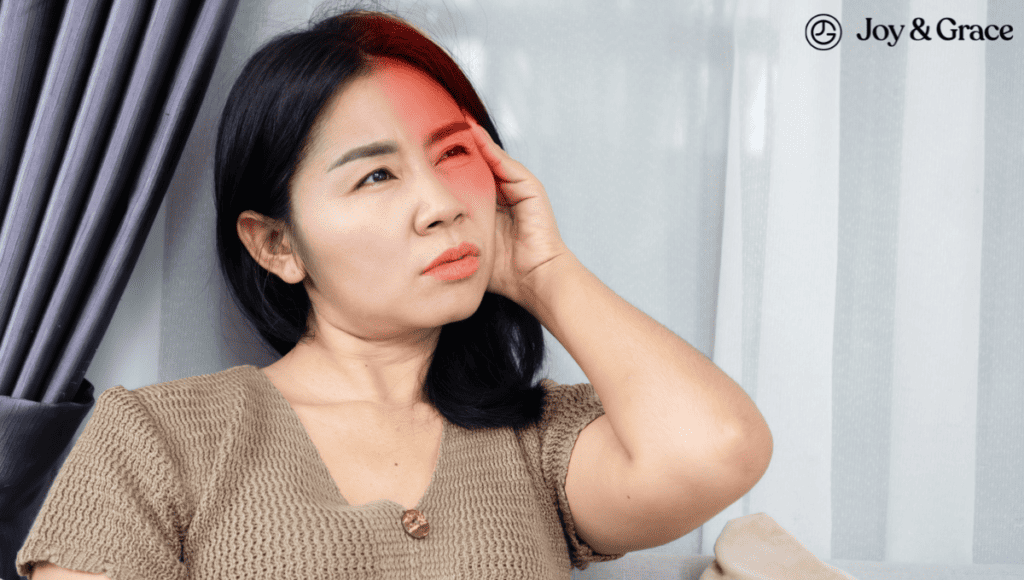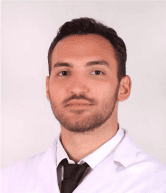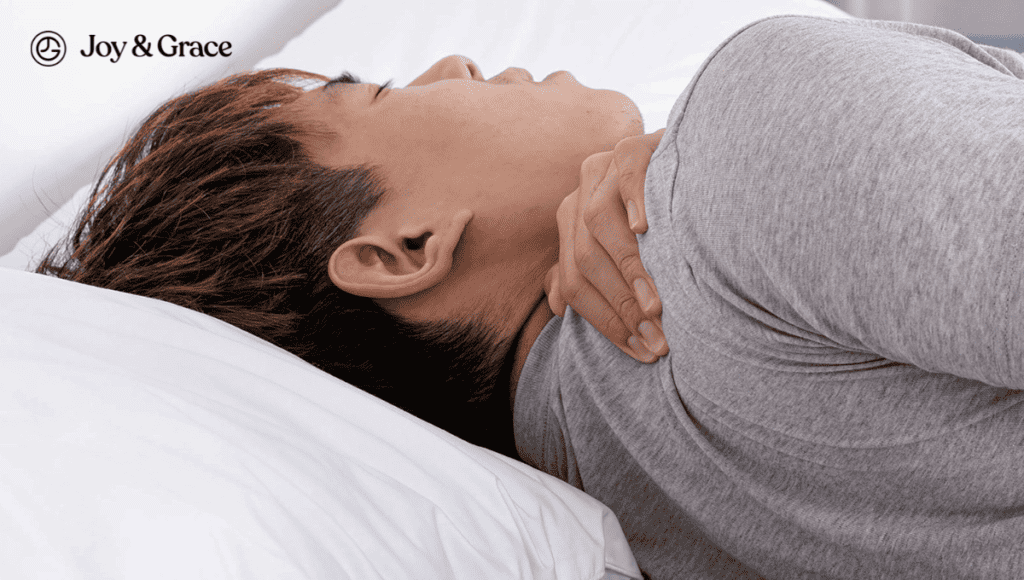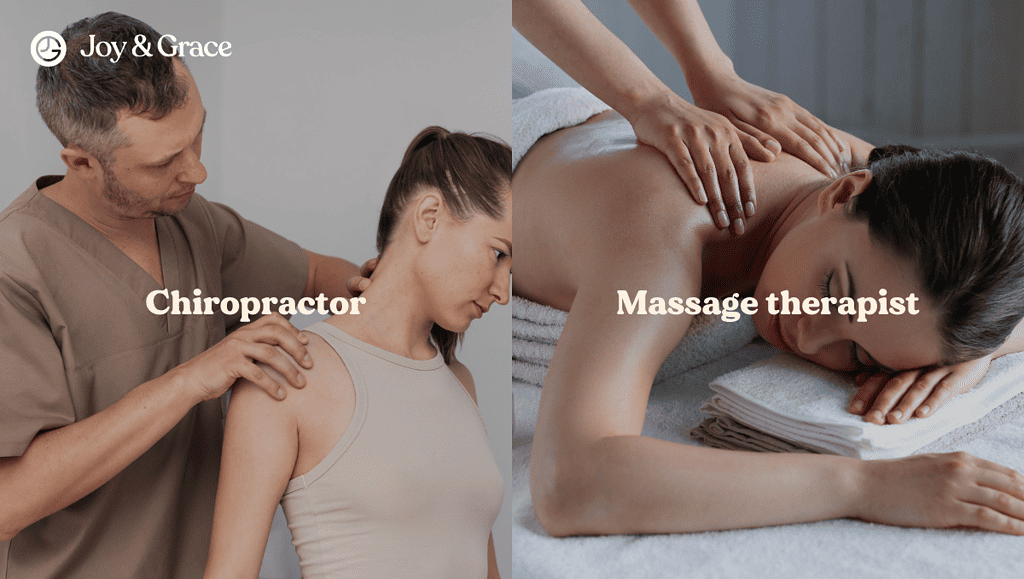Living with pain, especially when it affects your head, neck, or eyes, can feel daunting. It becomes even more perplexing when it's localized to just one side. But you’re not alone. This specific combination of symptoms is more common than you think.
And the good news is that it can be successfully managed! Join us as we discuss all you should know about the likely causes of your one-sided pain.
What’s a One-Sided Headache Behind the Left Eye and Neck?
One-sided headaches can be perplexing, especially when they manifest behind the left eye and spread to the neck. While it's natural to assume the head is the primary source of pain, it's not always so straightforward. Sometimes, the discomfort can actually originate in the neck or eye but then evolve into a full-blown headache.
This is why understanding the specifics of such headaches is crucial. Given their varied characteristics and underlying conditions, pinpointing the root cause is essential. Identifying the true source of the pain not only aids in effective treatment but also in preventing recurrence.
Let's dive deeper into the intricacies of these one-sided headaches and the importance of diagnosing their root cause.
What Causes Pain on the Left Side of the Neck and Head?

A left-sided headache with neck pain and potential pain behind the left eye may be attributed to various conditions. Below, we've listed 15 causes (from common to less common). We've also grouped them based on whether they typically present with accompanying (systemic) symptoms or not.
Conditions with typically no accompanying (body-wide) symptoms:
- Cervicogenic headache (Headache originating in the neck)
- Migraine
- Tension headache
- Cluster headache
- Paroxysmal hemicrania
- SUNCT (Short-lasting unilateral neuralgiform headache)
- Occipital neuralgia
Conditions with potential accompanying symptoms:
- Infections (including sinus infections)
- Seizure
- Stroke (hemorrhagic and ischemic)
- Brain aneurysm
- Arterial dissection
- Giant-cell (Temporal) arteritis
- Traumatic brain injury
- Brain tumors
That’s quite a long list, huh? We’ll discuss them one by one.
But before diving in, it's essential to understand one thing:
Some conditions on this list (especially those towards the end) often manifest with symptoms so intense that most people would immediately seek medical attention at a hospital. Nonetheless, we’ll still mention them to raise awareness.
As always, please consult with a healthcare professional about persistent or severe symptoms.
1. Cervicogenic Headache: Can Neck Pain Cause Head and Eye Pain?
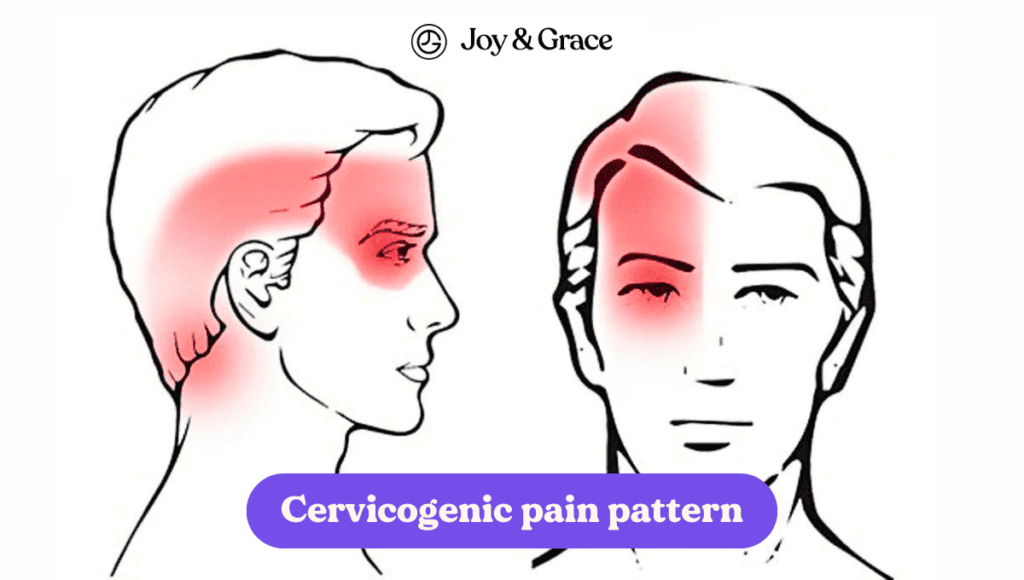
Yes, neck pain can cause head and eye pain. This type of neck pain that causes a headache has its own name: cervicogenic headache (CGH). CGH is a unilateral or one-sided pain that starts on one side of the neck and spreads to the head and eyes.
It’s chronic, recurrent, and worsens with neck movement. CGH is uncommon and mostly affects people aged 30-44.
CGH arises as referred pain from C1, C2, and C3 nerve irritation.
C1, C2, and C3 are the first three vertebrae in the cervical spine (neck). Referred pain results from irritation in one body area but manifests in another.
Symptoms of Cervicogenic Headaches
Cervicogenic headaches are commonly mistaken for other headaches. Here are the symptoms and signs by which you can recognize them:
- One-sided (left or right) neck and head pain
The head pain is usually moderate to severe but not excruciating or throbbing (like in cluster headaches).
- Pressure or stiffness at the top of your neck (or base of your head)
- Headaches triggered by moving your neck
- Restricted neck range of movement (ROM)
- Referred pain behind the eyes accompanied by blurred vision
- Pain on one side of your shoulder or arm
- Rarely, increased sensitivity to light or noise, nausea, and vomiting
However, doctors have specific diagnostic criteria to identify cervicogenic headaches precisely. Let's delve into them.
Diagnosing Cervicogenic Headache: How is a Cervicogenic Headache Diagnosed?
The diagnosis of CGH should follow international guidelines, so there is a set of criteria to meet before a diagnosis of cervicogenic headaches can be suspected.
Here’s how the clinical diagnosis process goes:
| Clinical criteria for the diagnosis of cervicogenic headache: |
| Headache that occurs on only one side |
| Signs and symptoms that suggest neck involvement, such as:Headache that is triggered by neck movement or after holding an uncomfortable position for an extended period of time.Headache that is triggered by pressure on the back of the neckPain in the neck, shoulder, and arm on the same side as the headacheLimited neck movement |
| Can vary in duration or may be persistent with varying intensity |
| Moderate pain that is not throbbing in nature |
| Pain that starts in the neck and spreads to the front and sides of the head |
| Temporary relief of pain using anesthetic blockade of the neck. Alternatively, you may have a history of an injury to the neck immediately before the onset of headaches |
| Any of the following symptoms:NauseaVomitingEdema on the same side of the headacheFlushing in the area surrounding the eyesDizzinessBlurred visionSensitivity to light (photophobia)Sensitivity to sound (phonophobia) |
| Meeting criteria 1 and 5 qualifies for a diagnosis of “possible cervicogenic headache.” Meeting criteria 1 and 5 plus any of the other three criteria upgrades the diagnosis suspicion to "probable cervicogenic headache." |
Additional tests can be performed to support the diagnosis, such as:
- Nerve block injections to confirm the source of pain
- Imaging tests to show the presence of a neck lesion and rule out other causes
- CT (Computed tomography)
- CT myelography
- MRI (Magnetic resonance imaging)
Treatment options for Cervicogenic Headache
The first line of treatment for cervicogenic headaches is physical therapy. According to studies, more than two-thirds of patients report a 50% decrease in pain after a year of physical exercise and manipulative therapy.
However, physical therapy may worsen the headache at first.
To prevent this, treatment should start slowly. It should begin with gentle muscle stretching and manual cervical traction.
Manual cervical traction is a technique in which the therapist applies pressure to certain neck pressure points. It involves moving the neck in various ways, such as flexion, extension, and rotation.
Other potentially effective treatments for CGH include:
- Painkillers and other medications
Among medicines for pain, Tylenol and Ibuprofen are preferred. Other medicines (not intended for pain) have shown variable results.
- Nerve blocks
Nerve blocks for CGH may temporarily stop the pain-signaling function of the occipital nerves. They’re used for short-term relief.
- Intra-articular and epidural steroid injections
Injections containing steroids may be injected inside the vertebral joints or in the epidural space. Steroids may effectively reduce inflammation.
- Radiofrequency ablation (RFA)
RFA transmits radiofrequency waves through an inserted needle to “turn off” nerve fibers. It’s used for long-term pain relief.
- Transcutaneous Electrical Nerve Stimulation (TENS)
TENS involves the use of electrodes that produce low-voltage current to stimulate nerves and treat pain.
- Instrument-Assisted Soft Tissue Mobilization (IASTM)
IASTM identifies and resolves so-called deep tissue restrictions. These are like tight bands that make it hard to move your neck and cause pain.
- Mind-body therapy
- Cognitive behavioral therapy
Behavioral therapy aims to teach positive thinking and problem-solving. It embraces the idea of accepting your pain and overcoming the psychosocial barriers of recovery. - Biofeedback
Biofeedback intends to train the mind and body to become more aware of the body’s pain responses and how to manage them.
- Cognitive behavioral therapy
- Lifestyle changes and home remedies
Adopting a healthy posture, sleeping habits, and diet can positively impact your general well-being.
Surgery for CGH is only used as a last resort.
Physical Therapy for Cervicogenic Headache
Exercises for CGH can relieve headaches, neck pain, and stiffness. Here’s a quick guide on how to do them at home:
1. Neck Left-Right Rotation Stretches
While sitting or standing, turn your head slowly and look over your left shoulder. Then, slowly turn to look over the right shoulder. Repeat five times.
2. Neck Lateral Tilt Stretches
While sitting, tilt your head slowly towards your shoulder. Return to the middle and repeat on the other side. Repeat five times.
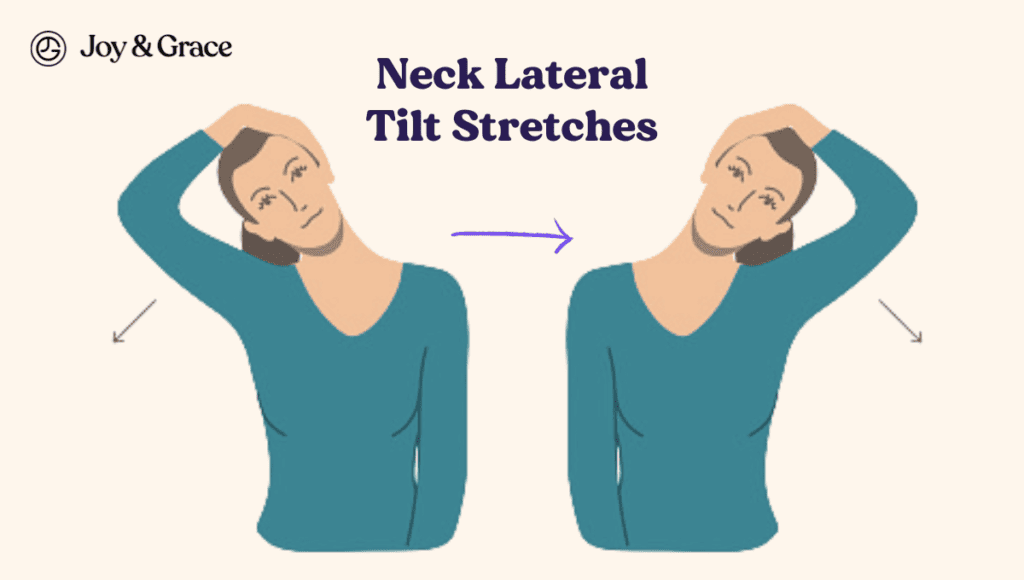
3. Neck Flexion Stretches (Chin Tucks)
While sitting, gently try to touch your chest with your chin. Hold for three seconds and repeat five times.
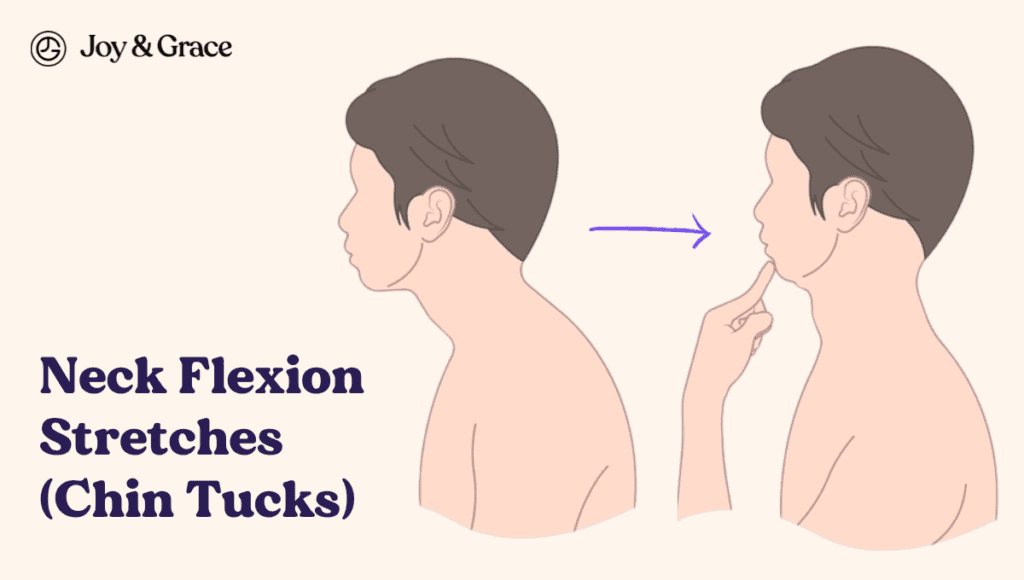
4. Shoulder Shrugs
While sitting or standing, shrug your shoulders upward, then bring them down. Repeat five times.
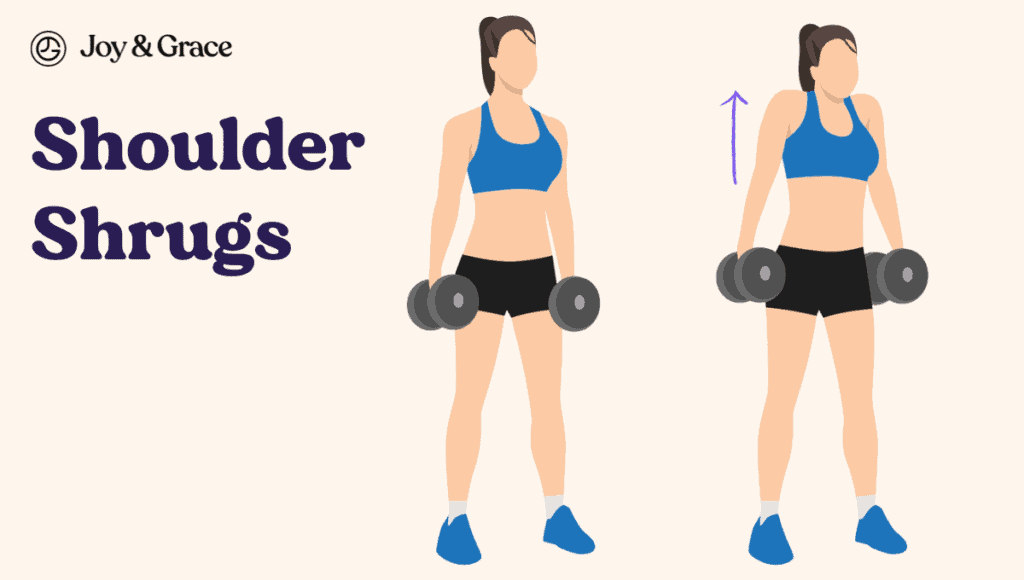
5. Seated Torso Rotation
Sit on a chair with your arms across your chest. Turn your body to the right and hold for five seconds. Then, turn to the left. Repeat five times on each side.
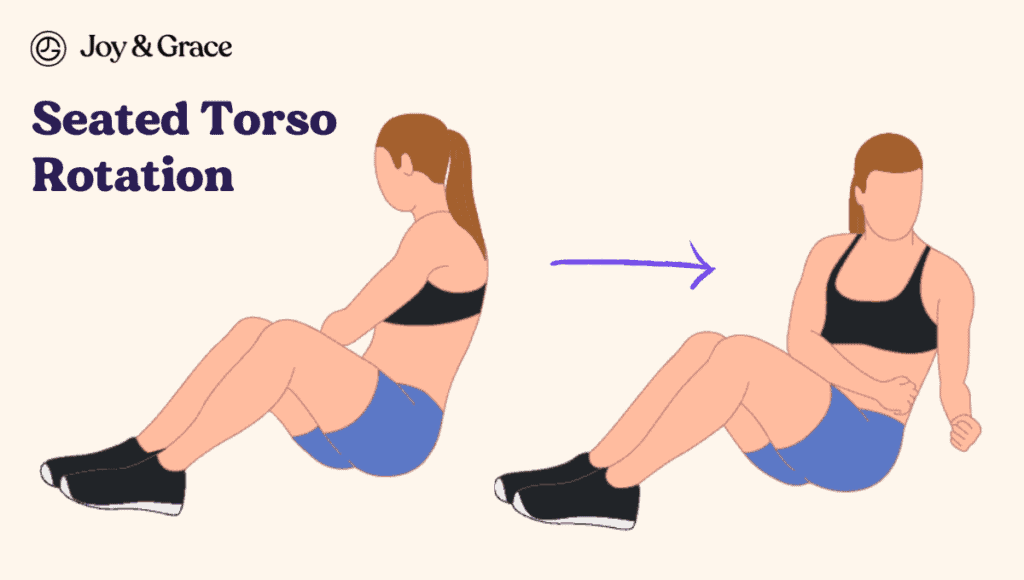
6. Overhead Arm Reaches
While sitting or standing, stretch both arms to the ceiling and try to reach as high as possible. Repeat five times.
Try to do these three to four times a day. Gradually and carefully increase the number of reps. If your pain gets worse, do fewer reps or stop altogether and seek your doctor’s advice.
What is Pain Behind the Right Eye and Neck?
The same factors we mentioned earlier may be to blame for pain behind the right eye and neck. Headaches associated with eye and neck pain are usually described as unilateral or one-sided. They may affect the left or right eye or any of the two halves of the head and neck.
2. Migraine
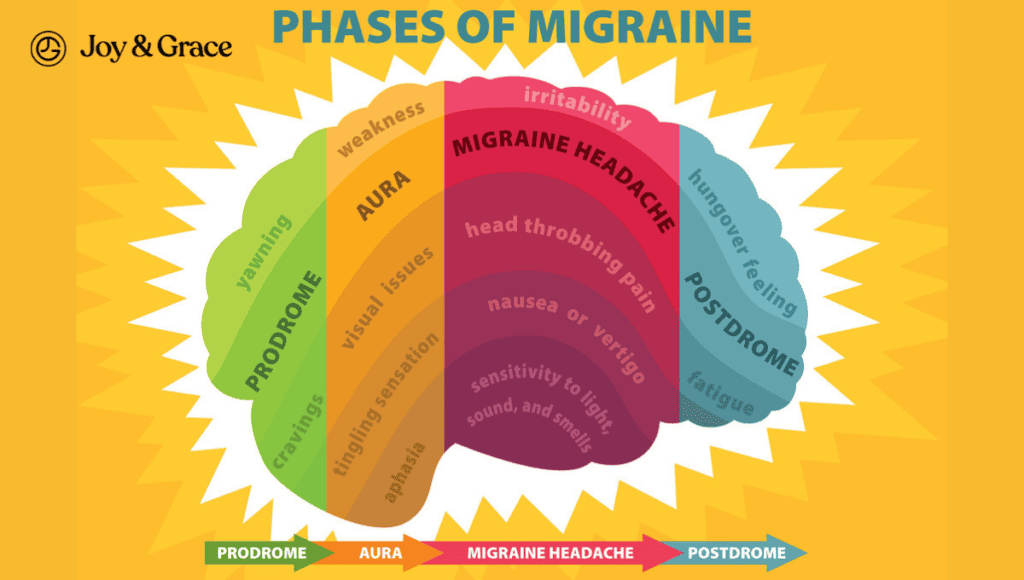
You’ve probably heard of migraines before. A migraine is a throbbing or pulsating headache on one side of the head. If left untreated, this headache comes in waves or attacks that may last 4–72 hours. The pain arises from the activation of nerve fibers within the protective layers of the brain (meninges).
Other common symptoms that accompany migraine headaches are:
- Pain behind one or (more rarely) both eyes
- Blurred vision
- Neck pain and stiffness: A 2021 study reports that about 9 in 10 people with migraines also experience associated neck pain.
- Increased sensitivity to light, noise, and smell
- Nausea and vomiting
Migraines commonly occur in the morning, after waking. They can happen with or without warning signs called “auras,” usually lasting less than an hour. Migraines usually affect middle-aged groups up to the age of 40. They occur in about 12% of the population in the US.
Certain triggers can raise the odds of migraine attacks happening. These include:
- The beginning of a period
- Anxiety and depression
- Stress and tiredness
- Not eating regularly or skipping meals
- Dehydration
- Too much caffeine
- Lack of physical activity
Migraine headaches are treated with medications.
3. Tension Headache

Tension headaches are the most common type of headache. They affect about 1 in 5 people worldwide and can occur at any age. Tension-type headaches are usually bilateral but can occasionally be felt only on one side, such as the left.
The pain is usually mild to moderate and may feel like pressure from a belt tightened around the head. The pressure may also spread to the face, jaw, neck, and behind the eyes.
Tension headaches can be caused by muscular problems, including:
- Neck injuries
- Stress
- Tight muscles in the neck and shoulders
- Poor posture
- Bad sleeping habits
4. Cluster Headache
Cluster headaches are severe headaches characterized by excruciating pain. The pain can be sharp, burning, or piercing and may last for weeks or months. Cluster headaches occur on one side of the head and are usually associated with pain behind one eye.
Neck-related symptoms can also be present. According to a study from the Headache Journal, neck stiffness is seen in 40% and tenderness in 29% of cluster headache attacks. The study found that movement of the neck (especially flexion, bending the head forward towards the chest) triggered cluster headaches in 9% of patients.
Cluster headaches are relatively rare, affecting less than 1% of the US population. They often start between the ages of 20 and 50.
5 and 6. Paroxysmal Hemicrania and SUNCT
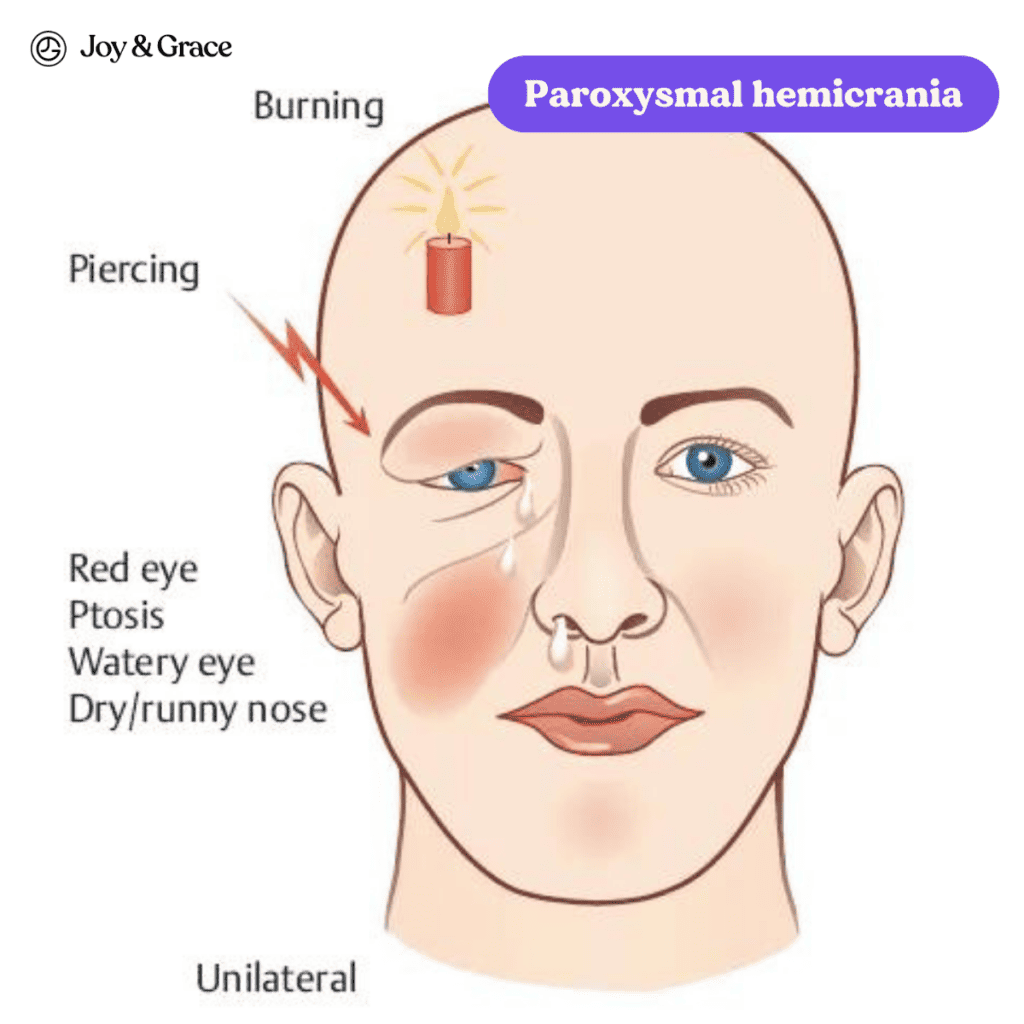
Paroxysmal hemicrania is a rare form of headache that belongs in the same group as cluster headaches. It affects 1 in 50,000 people and usually develops between the ages of 40 and 50.
Paroxysmal hemicrania is characterized by:
- Severe, throbbing, and claw-like pain on one side of the face, near the eye
- Pain around the back of the neck.
- Red and tearing eyes
- A drooping or swollen eyelid on the affected side of the face
- Nasal congestion
Attacks are frequent (5–40 times daily), each lasting 2–30 minutes. They may be triggered by specific movements of the head or neck or external pressure on the neck. About 1 in 10 people who have chronic paroxysmal hemicrania say that attacks start when they bend or rotate their head.
Another type of headache that’s similar to cluster headaches is called SUNCT. SUNCT stands for Short-lasting Unilateral Neuralgiform Headache. It’s a disorder that comes with infrequent attacks that last seconds. It’s seen in 1 in 15,000 people, while its age of onset is similar to that of paroxysmal hemicrania.
The pain can be severe, stabbing, and felt on one side of the face. It can also radiate to the neck and affect the eyes.
7. Occipital Neuralgia
Occipital neuralgia results from the injury or inflammation of the occipital nerves. The occipital nerves run through the back of the head.
According to a 2009 study, its incidence is about 3.2 cases per 100,000 people. Its mean age of onset is estimated to be 54 years old.
Pain may also arise when there’s muscle tightness in the neck. Occipital neuralgia is marked by the following symptoms:
- Headaches that feel like severe piercing, throbbing, or shock-like pain in the upper neck or back of the head. The pain is continuous and may affect one or both sides of the head.
- Pain behind the ears
- Pain behind the eye of the affected side of the head (when the pain is one-sided)
A movement as light as brushing hair may trigger pain. Occipital neuralgia may also be associated with other migraine-like symptoms.
Let's now shift focus to headaches which usually also cause body-wide symptoms. These often need emergency medical care.
8. Seizure
A seizure is a burst of uncontrolled electrical activity between nerve cells inside the brain. Seizures cause temporary, abnormal changes in muscle tone, behavior, sensations, or consciousness. Seizures as components of epilepsy appear more frequently in childhood or over the age of 60.
A seizure can cause migraine-like headache pain, which may occur during or after the seizure itself. Other symptoms may include:
- Nausea and vomiting
- Fatigue
- Increased sensitivity to light or sound
- Vision problems and eye pain
- Neck and shoulder pain (from the uncontrolled movements)
9. Infections
Infections can cause inflammation. Inflammation can then harm or destroy nerve cells. If this occurs in the brain or spinal cord, it can cause severe headaches.
Inflammation of the brain is called encephalitis. Meanwhile, inflammation of the surrounding layers of the brain and spinal cord is called meningitis. Both of these may also cause neck pain and stiffness. Encephalitis and meningitis affect 10-20 in 100,000 people and may occur at any age. Both of them require urgent medical attention.
While the brain is a primary source of infection-related headaches, it's not the only one. Sinus infections stemming from upper respiratory tract bacterial infections can also trigger headaches.
Although not as severe as conditions like encephalitis or meningitis, these sinus-related headaches share a similar inflammatory mechanism.
Sinus infections are characterized by:
- Constant, dull facial pain and tenderness
- Pain behind one or both eyes
- Nasal congestion
- Fever, cough, and fatigue
Infections that involve the head and neck should be treated with antibiotics or antivirals, among others. Without treatment, they may lead to serious complications, such as strokes and permanent brain damage.
10. Stroke
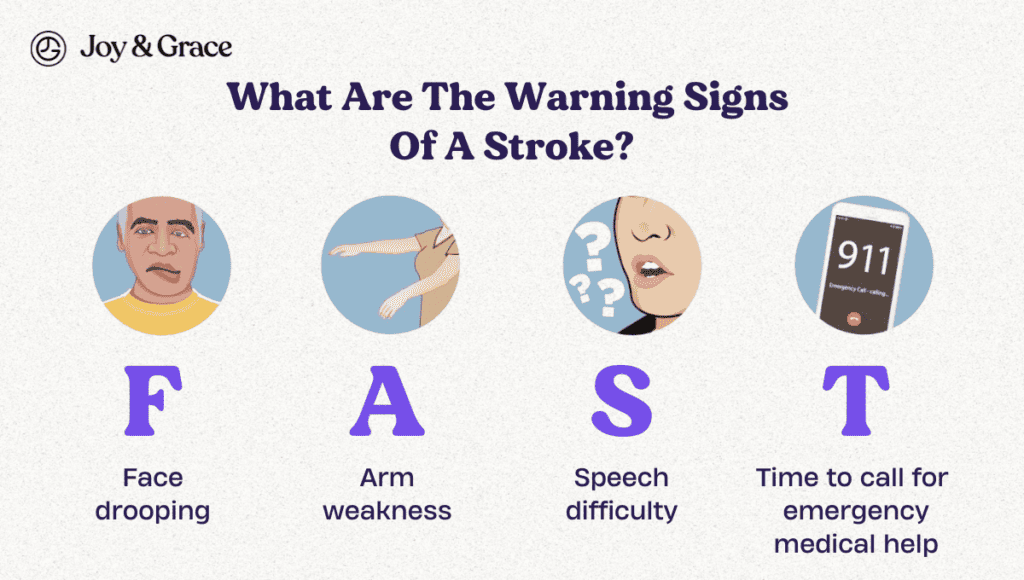
Blood vessel dysfunction can lead to a one-sided headache, too. One of the most notable medical conditions that affects blood vessels is stroke. A stroke is no joke; it can be deadly and affect any age.
Every 40 seconds, someone in the US suffers from a stroke episode. The risk of stroke increases significantly after the age of 55.
- Hemorrhagic
A hemorrhagic or bleeding stroke may occur when a blood vessel ruptures. As a consequence, blood is spilled into the brain tissue. Thunderclap headaches are a common term for the headaches brought on by this type of stroke. Patients commonly describe these as “the worst headache of my life.”
- Ischemic
In an ischemic stroke, a brain artery gets blocked. Hence, blood flow to the brain decreases or stops completely, causing brain cells to die.
A stroke may be accompanied by facial pain and drooping, which may affect the eye on the same side. Half of patients who have experienced a stroke have also reported associated neck pain. Other warning signs for stroke include:
- Numbness or weakness in your face, arm, or leg (especially on one side)
- Trouble speaking or slurred speech
- Confusion or trouble understanding others
- Difficulty seeing with one or both eyes
- Dizziness and trouble walking or staying balanced
If you even remotely suspect a stroke, call an ambulance immediately. “Time is brain” in these cases, and prompt medical treatment is crucial.
11. Brain Aneurysm
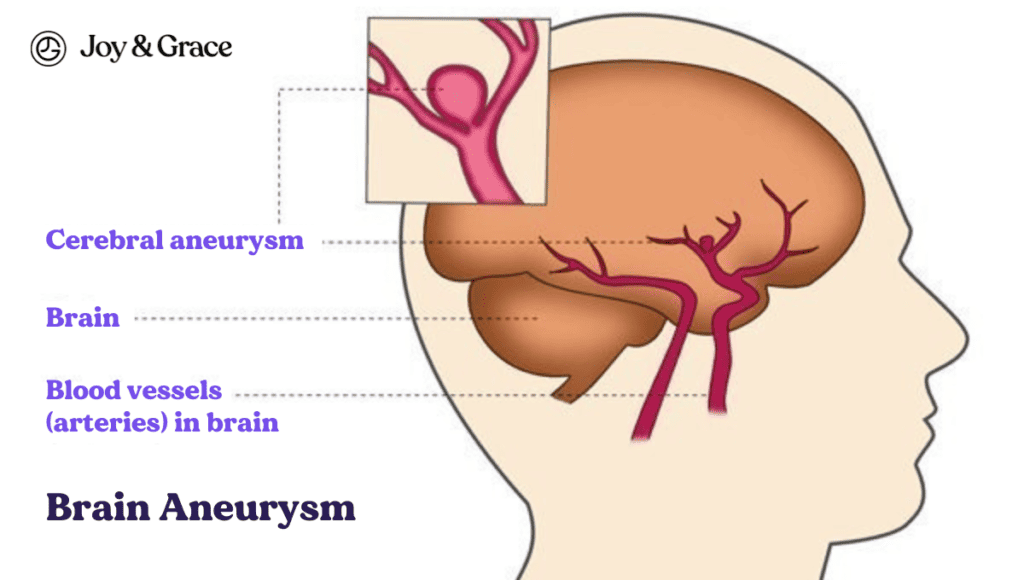
A brain aneurysm is a balloon-like growth inside the wall of a brain artery. An aneurysm may pulsate and mimic the signs of a migraine or cluster headache. This means it can be associated with a one-sided headache.
Brain aneurysms often go unnoticed until they rupture, and about 1 in 50 people in the US have one.
They usually develop after age 40. If an aneurysm bursts, it can cause a dangerous stroke. This happens to about 8-10 people in every 100,000 each year in the US.
Regular health check-ups can help catch problems early, making them easier to treat.
12. Arterial Dissection
An arterial dissection is a tear in the lining of an artery.
A tear in the carotid or vertebral arteries (the arteries that transmit blood to the brain) is known as cerebral arterial dissection (dissection comes from the Latin word dissecre, which means “to cut in pieces”). These arteries are located in the neck. Thus, cerebral dissection may also be associated with neck discomfort. Cervical artery dissection affects 4.9 in 100,000 people.
An arterial dissection can close off the passage of arteries, additionally leading to an ischemic stroke. It’s a rather common cause of stroke in people under 45 years of age.
13. Giant-Cell (Temporal) Arteritis

Giant-cell or temporal arteritis is inflammation and damage to the blood vessels that supply blood to the head, neck, upper body, and arms.
This condition is thought to be autoimmune (where the body mistakenly attacks itself). It usually affects the temporal arteries (found on the side of the head), which branch from the neck’s carotid arteries (the large arteries in your neck).
The symptoms and signs of giant-cell arteritis may include the following:
- Throbbing headache on one side of the head or the back of the head
- Tenderness when touching the scalp
- Pain and stiffness in the neck
- Blurred vision, double vision, or a sudden loss of vision
- Jaw pain that occurs when chewing (called jaw claudication)
- Pain in the upper arms, shoulders, and hips
- Weakness and tiredness
- Fever and a general feeling of being ill
How common is giant cell arteritis? A 2023 study tells us its incidence is between 18-29 cases per 100,000 people over the age of 50.
14. Traumatic Brain Injury (TBI)
One-sided headaches can often be symptoms of a head injury or trauma. The headache may develop immediately or, sometimes, even months after the injury.
It may be felt at the site of the injury, spread throughout the head, and affect other structures. The CDC estimates that each year, 1.5 million Americans sustain a TBI. The risk is highest among teens, young adults, and people older than 75 years. A head-related injury may also involve the neck, as in whiplash injuries.
An injury to the head and brain may affect the eyes, either directly or by causing something called accommodation spasm.
Accommodation spasm (pseudomyopia) is associated with abnormal eye function, blurred vision, and pain behind the eyes.
15. Brain Tumors
The word “tumor” is always scary to hear. But, thankfully, a headache very rarely implies there’s a tumor. The risk of brain tumors increases with age. It’s greatest in those aged between 85 and 89 years.
A tumor growing in the brain can press against nerve tissue and pain-sensitive blood vessel walls. It may even interfere with the blood supply to the brain.
Brain tumors can be of various types and sizes. Depending on where they’re located, brain tumors can cause different symptoms as well.
They can cause one-sided pain that comes and goes unpredictably. An adenoma (a pituitary gland tumor) may affect vision and cause eye pain. An occipital tumor, on the other hand, may also cause neck pain and vision changes.
Generally, brain tumors can give rise to the following symptoms:
- Headaches
- Seizures or convulsions
- Difficulty thinking, speaking, or finding words
- Personality or behavior changes
These changes may manifest as increased aggression, anxiety, or mood changes.
- Muscle weakness, numbness, or paralysis in one part or one side of the body
You might feel your left arm or leg feeling numb or weak. This means that sensations may be experienced differently. You might not be able to lift a 1-pound water bottle or walk properly.
- Loss of balance and dizziness
- Loss of hearing
- Vision changes (blurred vision, partial or complete blindness)
- Feeling confused and disoriented
- Memory loss
How Do I Stop a One-Sided Headache and Eye Pain?
The treatment of a one-sided headache depends on its cause. What you should do is address your problem as early as possible. We highly encourage you not to neglect your headache, neck pain, and eye pain. By consulting your doctor, you make sure you get the proper diagnosis and treatment.
In general, pain is treated with medications. Medications can also be used for other purposes that accompany headaches. Medications for migraine headaches, for example, can include:
- Painkillers
The most popular painkillers are Tylenol (paracetamol) and NSAIDs like ibuprofen and naproxen. Other painkillers may include narcotic analgesics.
- Triptans
- Medications that treat other symptoms
- Antiemetics (medications against nausea and vomiting)
- Beta-blockers and calcium-channel blockers (medications for blood pressure)
- Antiepileptics (medications against seizures)
- Antidepressants
What Treatments Are Available for Left-Side Head and Neck Pain?
As mentioned, treatment for left-sided head and neck pain is based on the underlying cause. Many types of treatment methods are available. Even more are being studied, developed, and tested daily. Common therapies for left-sided headache, neck pain, and eye pain are:
- Medications against pain and other symptoms
- Steroid injections
- Nerve stimulation therapies
- Physical therapy and exercise
- Behavioral therapy
- Lifestyle changes and home remedies, etc.
What Home Remedies Can Help Relieve Left-Sided Head and Neck Pain?
- Maintain good sleep hygiene.
This means you should aim to sleep at least 7-8 hours a night.
- Reduce screen time before bed.
- Adopt a regularly scheduled and healthy diet, avoiding food triggers.
- Exercise regularly.
- Consider a visit to an eye doctor.
- Manage stress and anxiety.
- Try meditation, mindfulness, or yoga.
- Apply heat therapy as needed.
- Visit a local headache support group (if available) to learn how others cope with their pain.
We have a more in-depth article on home remedies for headaches and neck pain if you’re interested in reading further.
When Should I See a Doctor for Left Side Head and Neck Pain?
You should immediately seek medical care if you experience any of the following symptoms:
- Sudden, severe headache with a stiff neck
- Severe headache along with a fever, nausea, or vomiting that’s not related to another illness
- Headache that’s described as “the first” or “the worst” and that goes with confusion, weakness, double vision, or loss of consciousness
- Headache that changes or worsens over days or weeks
- Recurring headaches in children
- Headache following a head injury
- Headache and a loss of sensation or weakness in any part of the body
- Headache with convulsions or shortness of breath
- Two or more headaches a week
- Persistent headache with no previous history of headaches (especially in someone over 50)
- A new headache in someone with a history of cancer or HIV/AIDS
Takeaway
A one-sided headache behind the left eye and neck affects the left half of the head and spreads to the neck and left eye.
Pain may also originate from the neck or left eye and present as a headache.
A left-sided headache with neck pain and potential pain behind the left eye may be attributed to the following:
1. Cervicogenic headache (Headache originating in the neck)
2. Migraine
3. Tension headache
4. Cluster headache
5. Paroxysmal hemicrania
6. SUNCT (Short-lasting unilateral neuralgiform headache)
7. Occipital neuralgia
8. Seizure
9. Infections (including sinus infections)
10. Stroke (hemorrhagic and ischemic)
11. Brain aneurysm
12. Arterial dissection
13. Giant-cell (Temporal) arteritis
14. Traumatic brain injury
15. Brain tumor
CGH is a unilateral or one-sided pain that starts on one side of the neck and spreads to the head and eyes. It’s chronic, recurrent, and worsens with neck movement.
The first line of treatment for cervicogenic headaches is physical therapy.
A migraine is a throbbing or pulsating headache on one side of the head. Migraines may also cause:
- Pain behind one or (more rarely) both eyes
- Blurred vision
- Neck pain and stiffness
Tension-type headaches are usually bilateral but can be felt only on one side, such as the left.
The pain is usually mild to moderate and may feel like pressure from a belt tightened around the head. The pressure may also spread to the face, jaw, neck, and behind the eyes.
Cluster headaches occur on one side of the head and are usually associated with pain behind one eye.
The treatment plan for a one-sided headache depends on its cause. Address your problem as early as possible. We highly encourage you not to neglect your headache, neck pain, and eye pain. By consulting your doctor, you make sure you get an accurate diagnosis and treatment.
